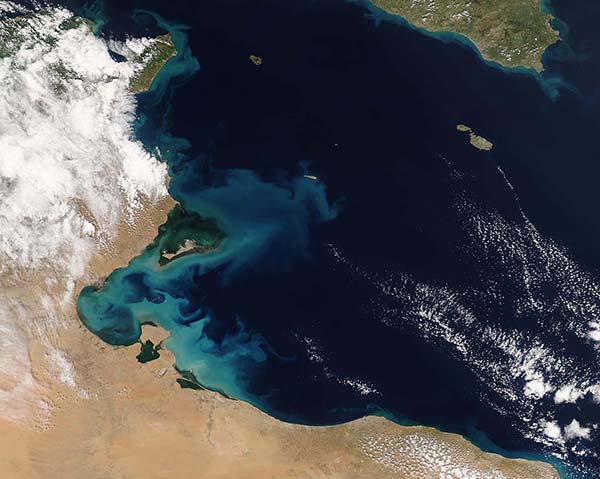Images
March 28, 2022 - Tunisia's Turquoise Waters
Tweet
On March 23, 2022, the Moderate Resolution Imaging Spectroradiometer (MODIS) on board NASA’s Aqua satellite acquired a true-color image of brilliant turquoise-tinted waters off the coast of Tunisia. This remarkably beautiful color is the result of a large bloom of phytoplankton—microscopic plant-like organisms that live in these waters year-round but, when conditions are just right, undergo explosive reproduction to create huge, colorful, floating colonies that are easily seen from space. The colors concentrate in the Gulf of Gabes, with tendrils of color reaching into the darker waters of the Mediterranean Sea.
Blooms of phytoplankton are common in this location in both the spring and the summer, when nutrients carried to the surface from upwelling in the Gulf of Gabes combine with warming water temperatures and lengthening daylight to create ideal temperatures for the organisms. Nutrient runoff from local rivers contribute to encouraging growth of phytoplankton. Most of the blooms off the coast of Tunisia are benign and may actually assist in the rich fishery found there as phytoplankton form the base of the marine food web, ultimately attracting and supporting species of fish with commercial value. Sometimes, however, blooms contain harmful species of phytoplankton. Called Harmful Algal Blooms (HABs), the organisms can release toxins that can cause illness in people or animals. One type of HAB is known as “red tide”, so called because the pigments in that organism cause a red tint to the water. No HAB has currently been reported off the Tunisian coast.
Image Facts
Satellite:
Aqua
Date Acquired: 3/23/2022
Resolutions:
1km (89.3 KB), 500m (193.5 KB), 250m (608.2 KB)
Bands Used: 1,4,3
Image Credit:
MODIS Land Rapid Response Team, NASA GSFC
Tweet
On March 23, 2022, the Moderate Resolution Imaging Spectroradiometer (MODIS) on board NASA’s Aqua satellite acquired a true-color image of brilliant turquoise-tinted waters off the coast of Tunisia. This remarkably beautiful color is the result of a large bloom of phytoplankton—microscopic plant-like organisms that live in these waters year-round but, when conditions are just right, undergo explosive reproduction to create huge, colorful, floating colonies that are easily seen from space. The colors concentrate in the Gulf of Gabes, with tendrils of color reaching into the darker waters of the Mediterranean Sea.
Blooms of phytoplankton are common in this location in both the spring and the summer, when nutrients carried to the surface from upwelling in the Gulf of Gabes combine with warming water temperatures and lengthening daylight to create ideal temperatures for the organisms. Nutrient runoff from local rivers contribute to encouraging growth of phytoplankton. Most of the blooms off the coast of Tunisia are benign and may actually assist in the rich fishery found there as phytoplankton form the base of the marine food web, ultimately attracting and supporting species of fish with commercial value. Sometimes, however, blooms contain harmful species of phytoplankton. Called Harmful Algal Blooms (HABs), the organisms can release toxins that can cause illness in people or animals. One type of HAB is known as “red tide”, so called because the pigments in that organism cause a red tint to the water. No HAB has currently been reported off the Tunisian coast.
Image Facts
Satellite:
Aqua
Date Acquired: 3/23/2022
Resolutions:
1km (89.3 KB), 500m (193.5 KB), 250m (608.2 KB)
Bands Used: 1,4,3
Image Credit:
MODIS Land Rapid Response Team, NASA GSFC




